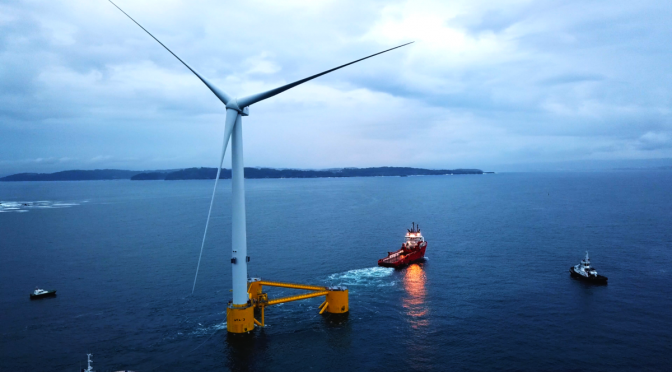The first WindFloat Atlantic unit – featuring the world’s largest offshore wind turbines on a floating platform – has departed for its final destination off the Portuguese coast of Viana do Castelo, where the commissioning of the floating wind farm will take place.
The wind power project will speed up the commercial deployment of innovative WindFloat® technology that harnesses the wealth of wind resources in transitional and deep waters, which were previously inaccessible. WindFloat Atlantic project marks an important milestone for the industry as this is the first semi-submersible floating wind farm in the world.
Because it can be placed in very deep waters, WindFloat® can unlock energy resources in vast areas of the sea, addressing major societal challenges, such as the clean energy transition, energy security and climate change, whilst bringing jobs, economic growth and opportunities for sustainable investment. Windplus is a consortium made up of EDP RENEWABLES, ENGIE, REPSOL and PRINCIPLE POWER.
The first WindFloat Atlantic platform with the wind turbine fully installed has set off from the Spanish Port of Ferrol towards its final destination 20 km off the coast of Viana do Castelo in Portugal. Once at the final location, the three floating structures –stretching 30 metres in height and with a distance between each one of their columns of 50 metres – will be installed to form the first floating wind farm in continental Europe.
The structure that has set off from the outer harbour of Ferrol comprises a floating platform and a wind turbine, the largest installed on a surface of these characteristics to date. In the coming months, two other platforms will be added to complete the windfarm which, with its 25MW installed capacity, will be able to generate enough energy to supply the equivalent of 60,000 users each year.
The wind energy project is led by the Windplus consortium, comprising EDP Renewables (54.4%), Engie (25%), Repsol (19.4%) and Principle Power Inc. (1.2%). The facility has three wind turbines mounted on floating platforms which are anchored only with chains to the seabed at a depth of 100 m. It includes cutting-edge technology that minimises the environmental impact and facilitates access to untapped wind resources in deep waters. This technology has wide-reaching benefits that enhance its accessibility and cost-effectiveness, including its aptness for dry-dock assembly and towing without the need for specialised towing craft, or the advantages of not having to rely on complex offshore operations associated with the installation of traditional bottom-fixed structures.
WindFloat Atlantic project builds on the success of the WindFloat1 prototype, which was in operations between 2011 and 2016. The 2MW prototype successfully generated energy uninterruptedly over five years, surviving extreme weather conditions, including waves up to 17 metres tall and 60-knot winds, completely unscathed.
The transport alone of the first of the three floating structures making up the floating wind farm at Viana do Castelo marks a milestone in itself, as it sidesteps the need for towing craft designed specifically for this process. This benefit, alongside the simple mooring process, make it possible to replicate this initiative in other geographical areas and facilitates the commissioning phase regardless of geographical boundaries.
The WindFloat can also support the world’s largest commercially available wind turbines on a floating structure of almost 9 MW each, helping to increase power generation and drive significant reductions in lifecycle costs.
The platforms have been built in cooperation between the two countries on the Iberian peninsula: two of the platforms were manufactured at the Setúbal shipyards (Portugal), and the third at Avilés and Ferrol shipyards (Spain). The project uses WindFloat disruptive technology, which enables wind platforms to be installed in deep waters, inaccessible to date, where abundant wind resources can be harnessed.
This initiative has had the support of public and private institutions, encouraging companies that are leaders in their respective markets to take part in the project; while the Government of Portugal, the European Commission and the European Investment Bank have provided financial support.
The partners that have made this project possible include Principle Power, the joint venture between Navantia/Windar, the A- Silva Matos Group, Bourbon, the wind turbine supplier MHI Vestas and dynamic cable supplier JDR Cables.


